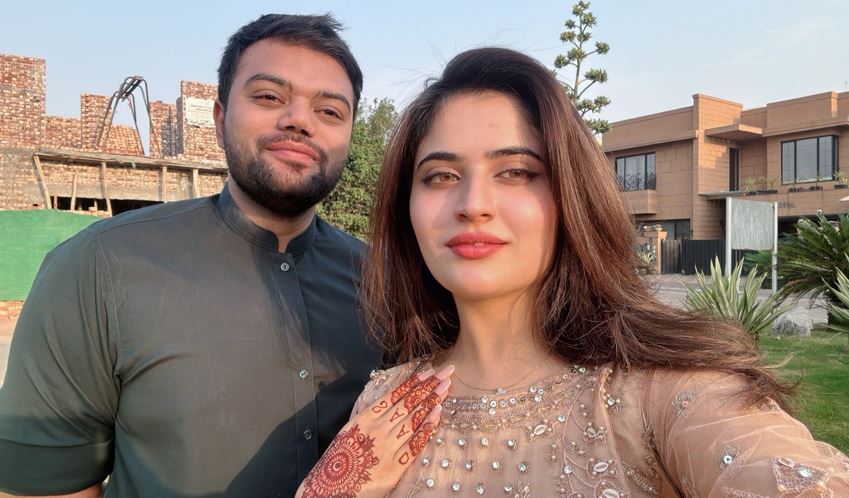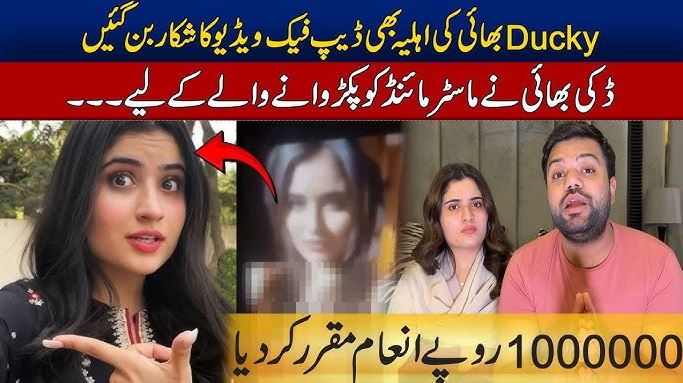Ducky Bhai’s Wife, Aroob Jatoi Viral Video Grapples with the Fallout
In an unsettling turn of events, Aroob Jatoi, the wife of popular YouTuber Saad Rehman, known as Ducky Bhai, has become the latest victim of deepfake technology. The incident came to light when a digitally manipulated video, falsely portraying Jatoi in a compromising situation, began circulating across various social media platforms. This viral video not only invaded her personal privacy but also sparked a significant outcry among the online community, highlighting the dark capabilities of deepfake technology.
Deepfakes, a portmanteau of “deep learning” and “fake,” are synthetic media in which a person’s likeness is replaced with someone else’s likeness, often without consent. These videos are crafted using sophisticated artificial intelligence and machine learning algorithms, making them increasingly difficult to distinguish from genuine content. The implications of this technology stretch far beyond mere pranks or satire; they pose serious threats to individual privacy, security, and the very fabric of trust in digital media.
The featuring Ducky Bhai’s wife, Aroob Jatoi viral video serves as a poignant reminder of the potential harm that these technological advancements can inflict on individuals, especially those in the public eye. As the video spread, the couple faced not only personal distress but also the formidable task of combating misinformation, a battle that many victims of deepfakes find overwhelming and, at times, insurmountable. This incident raises critical questions about the ethical use of AI and the responsibility of social media platforms to curb the spread of such harmful content. As we advance further into the digital age, the need for stringent measures and regulations to protect individuals from such invasive technologies becomes increasingly apparent, underscoring the importance of maintaining digital ethics and safeguarding personal reputations online.
Section 1: Incident Overview
The unsettling reality of deepfake technology hit close to home for popular YouTuber Saad Rehman, better known as Ducky Bhai, when his wife, Aroob Jatoi, became the subject of a viral deepfake video. This incident unfolded when an eerily realistic video surfaced online, portraying Jatoi in scenarios that were entirely fabricated. The video, characterized by its disturbingly authentic appearance, quickly caught the attention of netizens and began spreading like wildfire across various social media platforms.
The deepfake video was first noticed by eagle-eyed fans who raised concerns over its authenticity, given the known public persona of Jatoi. As the video proliferated, the speed of its dissemination was fueled by the algorithms that prioritize sensational content, regardless of its veracity. Platforms such as Twitter, Facebook, and Instagram became arenas for rapid sharing, with users unwittingly or knowingly spreading the deepfake further. This incident starkly highlights the double-edged sword of social media’s power: while it can foster community and connection, it can just as easily serve as a conduit for misinformation and harm.
The nature of the video, combined with the lack of immediate tools to verify its authenticity, created a vortex of confusion and distress among the audience. The video not only misrepresented Jatoi but also posed severe implications for her privacy and the public’s trust in digital content, showcasing the chilling efficiency with which deepfake technology can be weaponized against individuals.
Section 2: Immediate Reactions
The response from Ducky Bhai and Aroob Jatoi was swift and decisive. Realizing the severity of the situation, Ducky Bhai took to his platform, which boasts millions of subscribers, to address the issue head-on. In a detailed video, he explained the nature of deepfakes, emphasizing that the video in question was not real and was a result of malicious intent. Aroob Jatoi herself made a poignant appearance, expressing her distress over the violation and the personal invasion she felt. She also issued a stern warning about the dangers of cybercrimes, particularly targeting public figures and their families.
Their reactions extended beyond just clarifications; they initiated a broader dialogue about the implications of such technological abuse. Ducky Bhai announced that they would be taking legal steps to combat the spread of the video and urged his viewers to report any sightings of the deepfake instead of sharing it. This proactive stance was crucial in controlling further damage and served as a call to action for their fan base and the wider community to recognize and combat such digital threats.

The broader impact on their personal lives was palpable. Both Ducky Bhai and Aroob Jatoi faced immense psychological stress, as public figures whose lives are frequently under scrutiny. The incident brought to light the vulnerabilities associated with their public visibility and sparked conversations about the balance between public engagement and privacy. Their ordeal underscored the potential repercussions on a person’s public image and personal life, highlighting the need for increased awareness and protective measures against the misuse of digital technologies.
This episode not only affected the couple but also set a precedent for how public figures might tackle similar violations in the future. It illustrated the crucial role that public awareness, platform responsibility, and personal vigilance play in safeguarding against the manipulative potentials of modern technology. As they navigated through this crisis, Ducky Bhai and Aroob Jatoi became inadvertent advocates for more stringent controls on digital content creation and dissemination, advocating for a safer online environment for all.
Section 3: Public and Personal Responses
In the wake of the viral deepfake video, Ducky Bhai’s reaction was one of both dismay and determination. He publicly condemned the invasion of privacy, expressing his profound disappointment and frustration over the exploitation of his wife’s image. His video messages conveyed a mix of personal pain and a call to arms against such cyber violations, emphasizing the dire need for digital literacy and stronger safeguards online. Ducky Bhai’s personal distress highlighted the human cost of digital impersonation, driving home the point that behind every public figure is a private individual deserving of respect and privacy.
Aroob Jatoi herself took a stand by advising other women on the importance of vigilance in the face of rising cybercrimes. She urged her followers and viewers to be cautious of the content they consume and share, highlighting the broader implications of digital content manipulation for women, who are often disproportionately targeted by such attacks. Her advice resonated with many, serving as a wake-up call to the pervasive dangers lurking in the digital shadows, particularly for those in the public eye.

The public reaction to the incident was notably divided. While many fans and supporters rallied behind Ducky Bhai and Aroob Jatoi, offering sympathy and solidarity, some critics pointed fingers at the couple’s decision to maintain a high-profile public presence. They argued that the exposure inherent to their online activities made them more susceptible to such attacks. This criticism sparked further debate among netizens about the responsibilities of content creators, especially those who involve their families in their public personas. Despite the mixed reactions, the incident undeniably stirred a broader conversation about privacy, consent, and the ethical boundaries of online content.
Section 4: The Fallout
The ramifications of the deepfake video were far-reaching for Ducky Bhai and Aroob Jatoi, affecting both their professional endeavors and their personal lives. Professionally, the couple faced the challenge of managing their public image amidst the scandal, striving to reassure both fans and sponsors of their integrity and the falsity of the video. This incident underscored the vulnerabilities associated with a public life mediated through digital platforms where control over one’s image can easily be usurped by malicious actors.
On a personal level, the stress and anxiety induced by this violation imposed a significant emotional toll on them. The invasion of privacy not only challenged their sense of security but also their trust in the digital ecosystem that had otherwise supported their careers. The couple had to navigate the delicate balance of addressing public scrutiny while managing their personal trauma, a daunting task that many public figures face when personal content is misused.

In response to the crisis, Ducky Bhai announced a substantial reward of one million rupees for information leading to the apprehension of the perpetrators. This move was not just about seeking justice but also about deterring future cybercriminals. By setting this precedent, Ducky Bhai aimed to spotlight the seriousness with which he viewed such offenses, hoping to inspire similar actions from others in the community and to encourage law enforcement to prioritize these cases.
The long-term effects of this incident on their careers are yet to be fully realized, but the immediate aftermath has certainly sparked significant discussions on legal reforms and the ethical use of technology. The reward offer, combined with their public statements, has potentially set the stage for more robust actions against the misuse of digital tools and for the creation of a safer online environment. As they move forward, Ducky Bhai and Aroob Jatoi continue to advocate for victims of similar violations, aiming to transform their ordeal into a catalyst for change in the digital domain.
Section 5: Ethical Considerations
The emergence of deepfake technology has ushered in a new era of digital content creation, one that blurs the lines between reality and fabrication with alarming precision. While the technology holds potential for innovation in fields like entertainment and education, its misuse raises significant ethical concerns. The case of Aroob Jatoi is a stark example of how deepfakes can be weaponized to harm individuals, violating their privacy and dignity with just a few clicks. The ethical quandary lies in the dual-use nature of this technology, which can both enrich and exploit, depending on the intent of the user.
A primary ethical issue is the lack of stringent controls over the creation and dissemination of deepfake content. Current regulations lag behind the rapid advancements in AI technology, creating a regulatory vacuum where malicious actors can operate with impunity. The ease with which individuals can create and spread falsified content calls for an urgent reassessment of digital rights and responsibilities. This gap in governance exposes individuals to harm and erodes trust in digital media—a foundation upon which much of modern communication and commerce rely.
Incidents like the one involving Jatoi not only spotlight the personal costs but also have broader implications for regulations and the perception of digital content authenticity. They force regulators and policymakers to confront the realities of digital manipulation, pushing for the development of new legal frameworks that can keep pace with technological advancements. Additionally, these incidents influence public perception, potentially leading to a widespread distrust of digital content. This could stifle the acceptance of beneficial technologies due to fears of misuse, setting back progress in various digital arenas.
Section 6: Implications for Content Creators
For family vloggers and other content creators who frequently share aspects of their personal lives online, the rise of deepfake technology poses unique challenges and risks. These creators often build their livelihoods on the trust and engagement of their audience, sharing personal moments to create connections and content. However, this openness can also make them vulnerable to attacks like those experienced by Ducky Bhai and Aroob Jatoi. The incident serves as a cautionary tale, prompting content creators to reassess the boundaries between their public personas and private lives.

The implications for content creators are manifold. First, there is a need for enhanced digital hygiene and security measures to protect their content from being manipulated. Creators must be more vigilant about how their images and videos are being used, potentially employing watermarking and other technologies to verify authenticity. Secondly, the incident underlines the importance of legal protection. Content creators need to be aware of their rights and the legal recourses available should they fall victim to such digital assaults.
Opinions are divided on whether family vloggers should limit their exposure or continue to embrace the transparency that often drives their success. Some argue that a reassessment of content strategy is necessary, suggesting that creators find ways to engage audiences without compromising their or their families’ security. This might include sharing less personally identifiable information or creating content that focuses on storytelling rather than real-time updates on family life.
Others believe that retreating from public view is not the solution, advocating instead for stronger community standards and technological solutions to protect content integrity. They call for platforms to take a more active role in detecting and flagging deepfake content, and for collaborations between tech companies, creators, and regulators to forge pathways that safeguard content without stifling creativity.
In conclusion, the rise of deepfake technology is a double-edged sword for content creators, offering new creative possibilities but also exposing them to new vulnerabilities. The incident involving Aroob Jatoi underscores the need for a balanced approach that protects individuals while fostering an environment where digital innovations can thrive without causing harm. As the digital landscape continues to evolve, so too must the strategies employed by those who live and work within it, ensuring that they can continue to create and share content with confidence.
The incident involving the Ducky Bhai’s wife, Aroob Jatoi viral video underscores the urgent challenges posed by advanced digital technologies. As we’ve discussed, the capacity of deepfake technology to create hyper-realistic but entirely fabricated content can have devastating personal and professional repercussions for individuals, particularly those in the public eye like Aroob Jatoi. The rapid dissemination of the manipulated video across various social platforms highlights the vulnerability of digital identities in today’s interconnected world, where the boundaries between truth and falsehood are increasingly blurred.
This episode has broader societal implications, signaling a potential crisis in digital trust and security. It illustrates a growing need for stringent controls and ethical standards in the use of AI-driven technologies like deepfakes. The case of Ducky Bhai and Aroob Jatoi reveals the dark potential of these tools to harm individuals’ reputations and mental health, and it raises questions about the responsibilities of platform providers in curbing the spread of malicious content.
To combat such threats, several preventive measures could be implemented. Enhancing digital literacy is crucial so that internet users can better distinguish between genuine and manipulated content. Educational initiatives should focus on the workings of AI technologies and the tell-tale signs of digital manipulations. Additionally, there needs to be a concerted effort from both tech companies and regulators to develop more robust mechanisms for detecting and flagging fake content to prevent its spread.
Ultimately, the incident involving the viral video of Ducky Bhai’s wife, Aroob Jatoi, not only highlights the personal cost of technological misuse but also serves as a wake-up call for society to reinforce digital safeguards and ethical standards. As digital technologies evolve, so too must our strategies for maintaining the integrity and trustworthiness of digital content.
Video -